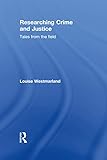Researching crime and justice/ tales from the field Westmarland,Louise
Material type: TextPublication details: Abingdon, Oxon: Routledge, 2011Edition: 1st.edDescription: x, 198 pISBN: 9781843923176DDC classification: 364
TextPublication details: Abingdon, Oxon: Routledge, 2011Edition: 1st.edDescription: x, 198 pISBN: 9781843923176DDC classification: 364 | Item type | Current library | Call number | Status | Date due | Barcode | Item holds |
|---|---|---|---|---|---|---|
|
|
Central Library, Sikkim University General Book Section | 364 WES/R (Browse shelf(Opens below)) | Available | P31900 |
Browsing Central Library, Sikkim University shelves, Shelving location: General Book Section Close shelf browser (Hides shelf browser)

|

|

|

|

|

|

|
||
| 364 STO/C Criminal Justice Management, 2Nd Ed./ | 364 VOG/C Crime, inequality and the state | 364 WAT/I International criminology/ | 364 WES/R Researching crime and justice/ | 364.01 AND/E Environmental Criminology/ | 364.01 BAR/E Explaining crime/ a primer in criminological theory | 364.01 TIB/C Criminological theory: A text reader/ |
Problematising criminological research
Introduction
What are 'criminological methods'?
'Real' research
Is researching crime and justice criminology?
What are criminological research methods?
If this is criminology, what is research?
How and why to research?
Who or what to research?
What is criminological about certain types of research?
What happens in 'real life' research?
Organisation of the book
Quantitative versus qualitative methods
Introduction
Choosing and using research methods
Is this criminology?
Types of research methods
How to choose methods that fit
Researching the 'truth' about rape
Reliability
Validity
The science of research methods
Conclusion
3 Quantitative methods
Introduction
What are quantitative criminological methods?
Primary and secondary data
Interrogating official statistics
Interview with John Muncie
Critiquing government statistics
Summary of secondary quantitative data methods
Primary data research
Summary of primary data research
Conclusion
4 Qualitative methods
Introduction
Versions of qualitative research
Interviews
Interview with Ben Bowling
Interview with Laura Piacentini
Focus groups
Mixed methods
Interview with Sandra Walklate
Interview with Lynn Hancock
Conclusion
) Soft and semi-structured research
Introduction
Ethnography
Insider/outsider research
Interview with Rob Hornsby
Interview with Simon Winlow
Conclusion
I Ethics, emotions, politics and danger
Introduction
Research ethics
Ethical restrictions on criminological research
Crime and justice specific ethics?
The politics of researching crime and justice
Emotions 162
Danger in the research process 166
Conclusion 168
Analysing evidence of crime and justice 169
Introduction 169
What the interviewees said 169
Analysing evidence 173
Theoretical concerns 174
A short guide to criminological theories 176
The themes that have arisen from the interviews 178
The writing up process 182
Conclusion 184


There are no comments on this title.